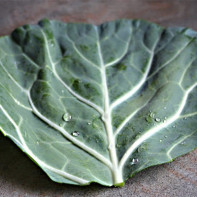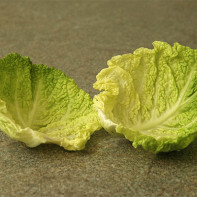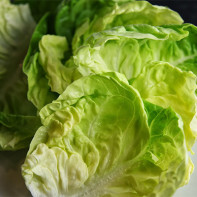Cabbage leaf: medicinal properties and contraindications
Cabbage leaf is the simplest and most accessible medicinal and culinary ingredient. It contains a great therapeutic potential, so it has been used for more than the first century. Its advantage is that it is available at any time of the year and inexpensive, but it has almost no contraindications for use. To start using the cabbage leaf for medicinal purposes, it is worth knowing what benefits it contains and for what diseases it helps.
- Chemical composition
- Therapeutic properties of cabbage leaf
- Cabbage leaf in folk medicine
- For headaches
- For sore throat
- For mastopathy
- With burns
- With gout
- Osteoarthritis in the knee
- For bruises
- In neuralgia
- Varicose veins
- For coughs
- Lactastasis
- For fever
- For spurs
- For osteochondrosis
- For fractures
- For hemorrhoids
- In flus
- Cosmetic Applications
- Culinary Applications of Cabbage Sheets
- Cabbage rolls
- Battered cabbage leaves
- Meat balls in cabbage leaves
- Can I Freeze Cabbage Leaves
- Can I give cabbage leaves to rabbits and piglets?
- Contraindications to use
Chemical Composition
Cabbage - a treasure trove of valuable trace elements, the power of which can be used for therapeutic purposes. This leafy vegetable contains vitamins, organic acids and mineral compounds. All the useful properties of this plant are due to its rich composition. To skillfully use it for recuperation, it is important to know what is included in the composition:
- Vitamins A, K, E, C, B9, B1, B2, B6;
- mineral compounds: potassium, calcium, zinc, sulfur, molybdenum, boron, chlorine, phosphorus;
- Amino acids: arginine, lysine, methionine, tryptophan, threonine, histidine, valine;
- plant hormones;
- organic acids;
- polysaccharides;
- flavonoids and antioxidants.
The main advantage of cabbage leaf, which is relevant when taken orally, is its low caloric content. You can not worry about the figure, using cabbage for the treatment of various diseases. Moreover, it extremely rarely provokes allergic reactions, and is not toxic for children, so its therapeutic potential can be used even for them.
Therapeutic properties of cabbage leaf
Cabbage leaf is of great value for folk and traditional medicine because it has a number of useful properties. This product can in some cases even replace medicines. As of today, there are 8 main medicinal properties of this product:
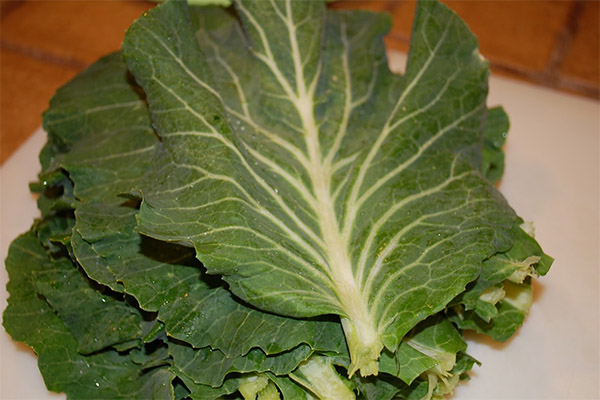
- It contains methylmethionine sulfonium - a substance that heals wounds and ulcers on the skin and mucous membranes.
- It has the ability to relieve vasospasms, so it is used for migraine, high blood pressure, pain of different localization.
- Able to block inflammatory processes.
- Contains a large amount of fiber, so when applied internally quickly cleanses the intestines, restores the natural microflora.
- It has a mild bactericidal effect, used as a disinfectant for mouth ulcers, sore throat, stomatitis, skin bacterial infections.
- It takes part in the metabolism of fats, so it helps to clear the blood vessels of cholesterol and promotes faster weight loss.
- Beneficial effect on the functioning of the reproductive system in men and women, contains vitamin B9, which prevents the development of cancer and benign tumors of the reproductive system.
- It has analgesic and anti-inflammatory properties, so it is used in diseases of the joints.
Cabbage leaf is an effective medicine that has almost no side effects. The only problem that people have to deal with when using it internally is increased gas. It is because of this that cabbage leaf is not recommended for flatulence.
Cabbage leaf in folk medicine
In alternative medicine, there are many recipes using cabbage leaves. This herb helps to cope with common diseases and ailments that can be cured without medication. It is also a natural remedy that promotes recovery for severe clinical conditions and health problems that require long-term treatment.
For Headaches.
This is perhaps the traditional way to fight headaches - applying a fresh cabbage leaf. It can be practiced at any time without fear of harm to the body. But if a person suffers from chronic headaches without any apparent pathological cause, you can use cabbage for a course of treatment and prevention. It is necessary to act as follows:
- take a cabbage leaf and steep it in boiling water;
- Cut it into two strips;
- Roll out the strips with a rolling pin so that the leaf lets the juice flow;
- Put it on the forehead and the back of the head and leave it overnight.
To fix the cabbage leaf, it is recommended to use an ordinary apothecary bandage. You can also take a piece of chintz fabric. The main thing is to make the bandage so that it does not squeeze the skin and does not interfere with blood circulation. The course of treatment of chronic headaches and migraines is 2 weeks.
Pain in the throat
A sore throat is a sign of an inflammatory process. It is not necessarily a sore throat, as this disease is an inflammation of the tonsils. A sore throat can be one of the symptoms of an ordinary acute respiratory infection. But in any case, you can use cabbage leaves as a medicine. There are several ways to use them.
- Squeeze the juice from the cabbage leaves. Take ½ cup of warm boiled water and add 50 ml of cabbage juice, mix and use the solution to gargle your throat 5-7 times a day.
- The cake of cabbage leaves, which was left from making the juice, mix with honey and wrap in gauze. Use as a compress - put on the throat area for 40-60 minutes, repeating three times a day.
- The easiest way to use cabbage leaves is to wash them and put them on your throat, tie them with a woolen scarf and walk around for 3-4 hours, and then replace the bandage.
With a sore throat you can also take 2 tablespoons of cabbage juice orally, diluted with water, in the morning, at lunchtime and in the evening. The juice will spur the immune system to fight viruses and bacteria, and accelerate the recovery of the body.
For mastopathy.
Cabbage leaves help with inflammation in mastitis. This herbal remedy stops the development of inflammation, prevents suppuration and blocks the development of pathogenic microflora. Fresh, sterile cabbage leaves should be used for mastopathy. Therefore, before using them, it is better to scald them with boiling water. It is recommended to apply a fresh, grinded with a rolling pin cabbage leaf on the affected breasts at night. If the inflammation increases, you can grind a couple of leaves on a meat grinder and throughout the day to rub every 2-3 hours sick breast with the juice obtained, and compresses do from the cake.
With burns
Cabbage leaf is used for burns of the first and second degree. This remedy helps to pain the affected area of the skin, as well as many times accelerate tissue regeneration and prevent inflammation, penetration of pathogens. There are two ways to use cabbage for burns.
The first way is the simplest. Take 3-4 leaves, rinse with boiling water, place in a sterile, clean bag and send it to the freezer for 3-5 minutes. Take the remedy out of the freezer and apply to the affected area of the skin. As soon as the sheet heats up, take a new one. The procedure should not be performed longer than 5 minutes, as overcooling makes the skin vulnerable to infections.
The second method is a little more complicated, but more effective. It can be used as an auxiliary treatment for extensive burns. Prepare a pulp of fresh, washed cabbage leaves, mix with hemp oil and make compresses. Hemp oil can be replaced by olive oil, as long as everything is sterile. Before applying the compress, treat the affected area with an antiseptic solution.
In gout
Gout is a disease that requires very long treatment. This disease is accompanied by severe pain. The condition can be alleviated with compresses based on cabbage leaves. In addition to the analgesic effect, cabbage also has a therapeutic effect.
Wash the cabbage leaves under cold water and cut them into convenient pieces for dressings. Fix them on the sick areas with a bandage or gauze, and walk around in this form all day. In severe pain replace the leaves every 2-3 hours. For a quick recovery from gout, it is also recommended to use cabbage juice internally, if there are no contraindications. The dose is 1 tablespoon 3 times a day. The course of treatment can be no longer than 30 days, and after that it is recommended to take a short break.
In osteoarthritis of the knee joint.
Cabbage is also effective for arthritis, especially during exacerbation. No other herbal remedy helps so quickly to cope with an exacerbation, block the inflammatory process and eliminate pain.
Recipe for arthritis:
- Take 200 g of fresh cabbage;
- Grind it on a meat grinder;
- Add to the resulting pulp 2 tablespoons of apple cider vinegar;
- Wrap in gauze, tie it to painful knees for 2-3 hours, you can leave it for the night.
Already after the first procedure, you can feel relief, as cabbage juice quickly penetrates through the skin to the joints where the inflammation began.
It is important to understand that arthritis is a chronic disease, it must be treated comprehensively, not only with cabbage juice. Folk medicine recommends supplementing the diet with dishes containing gelatin - these are broths, cold cuts, cauliflower fish, jelly. You can also supplement treatment by taking cabbage juice internally, 20 ml three times a day. Do not abandon the drug treatment, herbal remedies will only supplement it and enhance the effect of pharmacotherapy.
When bruised.
Cabbage helps to quickly cope with all kinds of bruises. Its juice contains substances that enhance tissue regeneration, promote resorption of bruises, relieve swelling and inflammation. To get rid of pain from a bruise and speed up the recovery of the affected tissue, you need to use cabbage leaf pulp for a compress. Take dense, juicy cabbage leaves, grind them on a meat grinder, add a small amount of badyaga powder and apply to the affected areas of the body.
In neuralgia
Neuralgia, regardless of the localization of the pathological process, can only be a consequence of other diseases, so before treatment, you need to consult a doctor to identify the real cause of the problem. Cabbage leaf can only help to cope with the symptoms, as well as reduce inflammation and relieve painful sensations. It is used for neuralgia in this way:
- Take 2-3 cabbage leaves and cut into small pieces.
- In a sieve or colander, steep with boiling water. Toss on gauze.
- Squeeze the water and in a warm form put together with marella on the affected area.
- The compress should not be tied tightly, using a natural cloth or a woolen scarf.
With caution, you should use this method with intercostal neuralgia. When making cabbage compresses, you must avoid the area near the heart. Intercostal neuralgia can significantly worsen the quality of life. The attacks of pain resemble the symptoms of cardiovascular and lung abnormalities, so proceed to home treatment only when there is an exact certainty that it is not the heart that hurts.
Varicose veins
With varicose veins, cabbage should become one of the main components of the diet, and you can use different kinds, because they all contain rutin. But also cabbage leaf can be used externally to make the manifestations of the disease less pronounced.
- On the affected areas, where dilated veins are noticeable, apply cabbage leaves steamed with boiling water and tie with an elastic bandage. The procedure should be repeated daily and should last at least 2 hours to show results.
- Prepare a pulp of 100 grams of cabbage leaves - grind them on a meat grinder, add to the mixture 1 teaspoon of table vinegar and 2 cloves of garlic. Rub this pulp into the skin areas where you can see the vein network, and wash off after 20-30 minutes. Repeat twice a day.
- Use cabbage leaves in season mixed with cherry leaves. Select the outer, greenest cabbage leaves and grind with a meat grinder. Cherry leaves also pass through a meat grinder. Make an ointment by mixing a mixture of the leaves of the two species in a ratio of 1:1, put it in gauze and use it for compresses at night.
Varicose veins in their late stages are often accompanied by thrombosis. This is a condition in which the use of cabbage and any other blood thinners is strictly contraindicated. Using cabbage for thrombosis can be life-threatening.
For coughs
If the cough is caused by a bacterial or viral infection and is one of the symptoms of an acute respiratory infection, you can cope with it with the help of cabbage. This product dilutes sputum, relieves inflammation, promotes the rapid clearing of the bronchi and lungs when coughing. The method of application is simple enough. It is necessary to perform the following actions before going to bed:
- lightly beat with a wooden mallet a couple of cabbage leaves;
- put them on the chest in the area of the lungs;
- bandage them with a woolen scarf.
If you have a severe cough or if it has become prolonged, you should use a compress on the chest and back and sleep with it. Repeat the procedure for 3 to 5 days.
With lactastasis
Cabbage leaf with lactastasis is used for compresses. It is applied to the breast 2 times a day to eliminate congestion. Massage with cabbage juice is also indicated. If congestion becomes chronic and requires constant correction of the condition, it is recommended to make nightly compresses of grinded on the meat grinder cabbage leaf and olive oil.
Cabbage leaf for lactastasis not only helps to eliminate stagnation, it also protects against the attachment of infections and the development of inflammation. The main thing is to make sure that the cabbage is clean: rinse it well with water or boil it. Oral use is not recommended during lactation, as cabbage is not useful for infants, it can provoke colic, abdominal bloating, cramps, severe diarrhea. But if you plan to end breastfeeding, you can drink 2 tablespoons of cabbage juice 2 times a day.
For fever
With fever, cabbage can be used in two versions - sauerkraut and fresh. Both of these varieties are equally good at helping to cope with fever. The fact is that cabbage contains substances that stop the process of inflammation, and along with this, the temperature decreases.
Instructions for use with fever:
- Apply sauerkraut leaves on the forehead, under the arms, on the stomach and on the feet.
- Cover with a thin linen sheet and lie down for 30 minutes.
- If necessary, after half an hour, replace the cabbage leaves.
The main disadvantage of this method is that the acid contained in sauerkraut can irritate the skin, which is extremely undesirable, especially when the temperature is high. A safer option is to use fresh cabbage leaves. Instructions:
- Break a cabbage cauliflower into leaves, rinse them with boiling water;
- Roll out with a rolling pin or beat them up lightly with a wooden mallet;
- Place on the forehead, shoulders, arms, stomach;
- cover with a light cotton cloth;
- Replace after 20 minutes.
Cabbage can bring down the temperature to normal levels for about 40-50 minutes. About the same amount of time is needed to wait for the effect of the antipyretic. It is important to remember to drink a lot while waiting for the temperature to drop.
The advantage of these methods is that they are used even for children. If your child has a body temperature not higher than 38.5, you can bring it down without medication or injections. But it is important to be sure that this plant does not cause an allergic reaction in the child, otherwise the condition will only worsen. Sauerkraut is not recommended for children under 6 years of age, as it can irritate sensitive children's skin. It is better to choose fresh leaves.
When spurs.
Heel spurs, cracked feet and various kinds of benign growths can be easily removed. You will need cabbage leaves, socks made of natural fabric and a little patience. Treat the spur as follows:
- Take two small cabbage leaves.
- Make small cuts on them every 0.5 cm, but do not cut them completely, just so that the leaves let the juice flow.
- Apply to the spurs and wear clean socks.
With such a compress go to bed. Worn during the day is undesirable - cabbage juice will work better at night, when all the resources of the body are aimed at regeneration and repair of tissues.
With osteochondrosis
Osteochondrosis - not the most dangerous disease, if you do not know what consequences it can lead to. Because of the cervical osteochondrosis can develop hypertension or even a stroke. Therefore, it is necessary to treat it with all available means. Cabbage leaf can serve as an auxiliary medicine, supplementing the main therapeutic course. There are three recipes that help to cope with osteochondrosis.
- Boil the cabbage leaf in boiling water for 5 minutes, take it out with a slotted spoon, wait until it cools to 40 degrees, put it on the affected area and bandage it.
- Wash the leaf under cold water, crush with a rolling pin, smear with honey. Apply to the cervical spine and tie with a woolen scarf. Leave the compress for the night. If burning or itching occurs, immediately remove and rinse skin with warm water or decoction of chamomile.
- You can treat osteochondrosis with cabbage leaf pulp, preparing it immediately before use. Salt the fresh cabbage leaf with sea salt so that it gives off the juice better and apply it to the neck, and then cover it with cling film and tie it with a scarf. The time of the procedure is 40 minutes.
Osteochondrosis can also be treated by rubbing the juice of cabbage leaves into the back of the head at least twice a day. The course of such treatment can take a month, but the result will be noticeable much sooner.
For fractures
As mentioned above, cabbage promotes extremely rapid repair of tissues and cellular structures. It also promotes rapid bone healing in fractures, helps to eliminate pain and inflammation. Instructions for using cabbage leaf for fractures:
- Boil 6-7 cabbage leaves;
- Apply them to the area of the body where there was a fracture;
- bandage with an elastic bandage;
- leave it for two hours.
Use cabbage for fractures only after the cast is removed! It is strictly forbidden to remove the cast to make a compress on your own - there may be a displacement, the bones will not fuse properly. Such self-treatment may even lead to disability.
Hemorrhoids
Hemorrhoids are a vein disease, so the use of cabbage is relevant. It contains vitamin C and rutin to strengthen the walls of blood vessels and make them elastic. It also prevents inflammation of the hemorrhoids.
You need to wash the cabbage leaves, dry them and beat them slightly so that they let the juice flow. Take a few leaves and put them on the sore spot for 20-30 minutes. It is important to apply the compress so that the cabbage as tightly as possible to the surface of the hemorrhoidal nodes. To enhance the effect, cover the compress with cling film on top. The time of such a procedure is at least 40 minutes. After that, take everything off, rinse off the rest of the cabbage juice with warm water or decoction of succession, and then use healing suppositories or oil.
You can also treat hemorrhoids with an ointment made from cabbage leaves. Grind the cheese on a meat grinder, and then mix the resulting porridge with honey in equal parts. Use the ready ointment to lubricate hemorrhoidal nodes after evening hygienic procedures. Treat with this ointment at least 2 weeks, then take a break. Already after 2-3 courses you will notice a significant reduction in hemorrhoids and achieve the elimination of discomfort.
Internal or combined hemorrhoids should not be treated with external compresses and ointments, but with enemas of freshly squeezed cabbage juice and cold boiled water. Mix cabbage juice with water in equal parts. Also, those diagnosed with hemorrhoids are advised to eat plenty of cabbage. You can supplement the treatment of internal hemorrhoids with cabbage juice, taking it orally by 20-40 ml. Most often it is recommended to drink 20 ml of cabbage juice in the morning and in the evening. You can drink only in the morning, but it is better to drink a double dose at once - 40 ml.
With flus.
If the gum is inflamed and the cheek is swollen, dentists do not always provide help until the inflammation subsides. Sometimes there is no possibility to go to the hospital, for example, if a person is out of town, or just a toothache during the holidays. Cabbage is a product that is almost always in every home. It can be used before going to the dentist to relieve the condition. So, there are 2 ways to treat flus with a cabbage leaf.
- Boil 3-4 cabbage leaves with a tablespoon of table salt in 500 ml of water. Put the warm leaves to the sore cheek and wrap it with a cotton diaper or scarf. After 2 hours, take a new leaf and change them throughout the day. The salt and active ingredients from the cabbage leaf penetrate through the skin to the site of inflammation, eliminate bacteria, relieve pain, and soothe.
- If the flus has just begun to set in, you can use a raw cabbage leaf. Stretch it with an ordinary rolling pin, and then put it to the sore spot and tie it with a bandage to hold it as tightly as possible. After 2-3 hours change the leaf. If there is no progress, and the flux only increases, it is better to use boiled leaves.
Applications in cosmetology
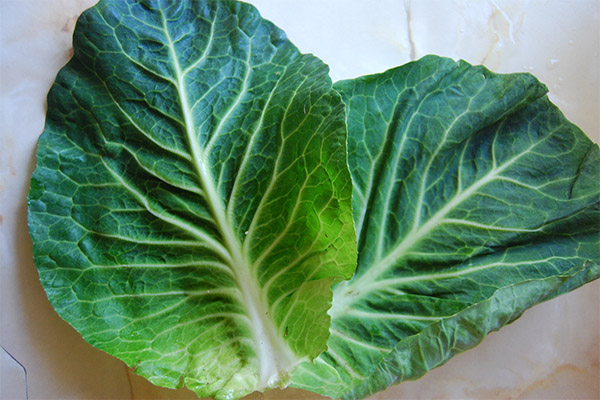
Cabbage leaf is widely used in home cosmetology. It is used to create grooming products. Due to its unique composition, this plant in the composition of grooming products is able to produce such effects:
- Stop hair loss;
- eliminate dandruff;
- Strengthen hair growth;
- Remove spots of baldness;
- improve complexion;
- Block inflammatory processes;
- eliminate acne.
To use the full power of cabbage for skin and hair care, it is important to know how to prepare proper care products from this plant.
- To stop hair loss, you need to rub the juice of cabbage leaf mixed with honey in a 1:1 ratio twice a week for half an hour, and then wash off with warm water.
- To activate hair growth and make them smooth, manageable, you need to prepare a mush of cabbage leaf, add a pinch of ground ginger and cinnamon and apply as a mask every 2-3 days. Wash off after 30-40 minutes.
- To soothe sensitive and inflamed facial skin, you need to cut cabbage leaves into small pieces, boil them, then soak them in olive oil and cover the affected areas for 20-30 minutes.
- You can use cabbage to fight cellulite. Wash the leaves, crush them with a clean wooden rolling pin and tape to the problem areas with food film. Walk with such a compress for at least two hours. The main thing is not to squeeze the skin too much so as not to disturb the outflow of lymph and blood circulation.
- You can use cabbage leaves for acne. Glue a small square of cabbage leaf onto an inflamed pimple with a plaster and leave it on overnight. In 7-10 hours, the herbal remedy will draw out the contents of the pimple, eliminate inflammation and activate the regeneration process.
- Cabbage leaf juice helps get rid of dark circles under the eyes. It is necessary to prepare juice from cabbage leaves and soak cotton pads in it, and then place them under the eyes for 20-30 minutes.
- Cabbage is used in cosmetology to eliminate couperose on the face. You need to put a crushed cabbage leaf for 20-30 minutes on the damaged areas of the skin. This is not always convenient, so you can use the alternative - juice.
- Sauce of cabbage can be used as a rejuvenating remedy. It should be applied along massage lines, rubbed into the skin and left on the face until dry, and then washed thoroughly with warm water.
- To remove seborrheic rash, you can prepare an oil mixture of cabbage leaf juice and olive oil. Mix in equal proportions in a bottle, shake vigorously before use.
- Cabbage leaf also helps to fight postpartum pigmentation. You need to crumple in your hand a couple of washed leaves and apply to the pigment spots for 10-15 minutes, repeat 2 times a day for a month.
As you can see, the cabbage leaf helps to cope with various appearance problems. But most importantly - it restores blood flow, strengthens nutrition, due to which in the long term prolongs youth and improves the appearance of the skin.
Using cabbage leaf in cooking
Cabbage leaf is widely used in cooking. It is a component of some national dishes. This product is versatile - it goes well with different kinds of meat, vegetables, cereals. If properly cooked, this product will retain its usefulness and taste. Below are described recipes for dishes made of cabbage leaf.

Cabbage rolls
About this dish knows probably every person living on the territory of the Slavic states. There are many variations of recipes, so everyone chooses what he likes. But the most popular is the traditional recipe.
Ingredients:
- 800 g of ground beef and pork;
- 1 cabbage;
- 1 cup boiled rice;
- 2 carrots;
- 2 onions;
- 2 tablespoons tomato;
- 800 ml of broth (can be replaced with water);
- salt, pepper, spices to taste.
First, prepare the cabbage. Remove the core from it, and then immerse the cabbage in boiling salted water for 10-15 minutes. Take out the cabbage, wait until it cools a little, and take it apart into leaves. Then follow the following instructions:
- Fry onion and carrot in vegetable oil.
- Mix one half of the roast with minced meat and rice, salt and pepper. Send the second half in a deep cauldron and add the tomato and broth.
- Wrap the stuffing in cabbage leaves.
- Wrapped stuffed cabbage rolls put into cauldron with boiling sauce and cook on low heat for 30-40 minutes.
- Serve hot with sour cream and greens.
Some housewives add an egg to the stuffing, so that the cabbage rolls won't fall apart and the stuffing will hold tightly in the leaves. You can also make a similar dish without rice at all or replace it with other additives to your liking.
Battered cabbage leaves
Although the cabbage leaf is considered the simplest and most accessible product, you can make a very tasty and original snack with it. Cabbage leaves in batter is a dish that is suitable for both everyday cooking and for the festive table.
List of ingredients:
- 10 medium sized cabbage leaves;
- 2 eggs;
- 2 tablespoons flour;
- 2 tablespoons milk;
- Salt and pepper to taste.
It is necessary to boil the cabbage for a while or to scald it with boiling water. After cutting the cabbage, cut the leaves into triangular or square pieces. Prepare a batter of flour, eggs and milk. Dip cabbage leaves in it and fry on a hot pan with oil. It is important to put the leaves on a dish with paper towels after frying to remove the excess oil. Before serving, garnish with fish caviar, herbs, smear with garlic sauce (a mixture of garlic, dill and mayonnaise).
Meat balls in cabbage leaves
You can bake cabbage leaves with meat. This vegetable product makes dishes more juicy and flavorful. Moreover, when combined with meat, cabbage is many times healthier, as it helps to digest proteins. It is very easy to prepare meat balls in cabbage leaves, the main thing is to follow the instructions.
Ingredients for the dish:
- 10 cabbage leaves;
- 600 g of minced pork;
- 2 onions;
- 1 garlic clove;
- 1 egg;
- tablespoon of tomato;
- a tablespoon of cream;
- pepper and salt.
It is necessary to prepare a form, pour a little vegetable oil into it and lay the onion cut into rings at the bottom. Next, wash small cabbage leaves, taking them preferably not from the top layer. Separately prepare the stuffing - mix 1 egg with the stuffing, onion and garlic, salt and pepper. Form small balls from the stuffing and place one on each cabbage leaf. Mix tomato paste and cream, salt and pepper, pour the dish and cover with foil. Send to the oven for 30 minutes, preheating it to 200 degrees.
Is it possible to freeze cabbage leaves
To prepare traditional cabbage rolls, many housewives freeze cabbage leaves for future use. The fact is that after freezing they become soft and you can easily wrap stuffing in them.
But this method of preparation has disadvantages. The fact is that in the process of freezing the structure of the cabbage leaf is disturbed. When the dish from the overfrozen product begins to boil, there is a risk that the leaf will simply boil or become watery, completely losing its original flavor qualities.
Can I give cabbage leaf to rabbits and piglets?
Cabbage leaf is not only a therapeutic remedy and food, it is also food for certain kinds of animals. People who keep rabbits and pigs sometimes notice a special interest in this vegetable for their wards. However, animals should not be allowed to eat cabbage uncontrollably.
It can be given to older rabbits, but only in small amounts and only as a treat. Pigs can also be given a small amount of cabbage (up to 300-400 g per day) as an adult. It is strictly forbidden to feed cabbage to animals during the period of nurturance. It is important to observe the reaction - often such food leads to digestive disorders and bloating. One month before slaughtering, animals should stop feeding cabbage, as it negatively affects the taste of meat.
Contraindications for use
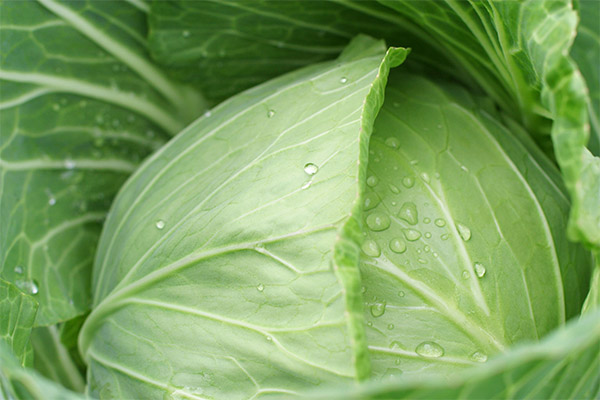
Cabbage leaf is not allowed in all cases. It may pose a danger to a person with such features and diseases:
- allergies to cabbage;
- Gastric and intestinal ulcers in the acute stage;
- Thyroid gland malfunction;
- diarrhea;
- tuberculosis (open form);
- thrombosis.
Otherwise, cabbage leaf is only useful. But when using it, side effects can occur, which should also be taken into account. It can develop flatulence, bloating, diarrhea, so it is better not to abuse it.
Cabbage leaf is a powerful natural medicine, as well as a versatile product that is used in the preparation of salads, side dishes, snacks. Knowing the rules of application, you can get the maximum benefits from this plant.
«Important: All information on this site is provided solely for introductory purposes. Before applying any recommendations, please consult with a specialist. specialist before using any of the recommendations. Neither the editors nor the authors shall be liable for any possible harm caused by materials."

